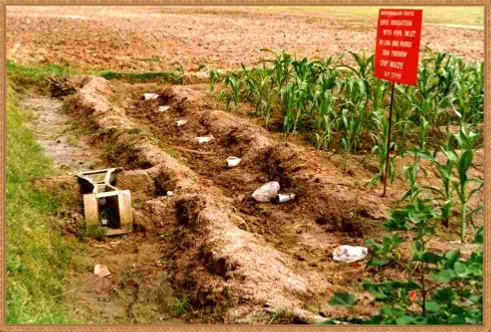
|
|
| Home | Seasons & Varieties | Tillage | Nutrient Mgmnt | Irrigation Mgmnt | Weed Mgmnt | Crop Protection | Cost of Cultivation | Photobank | |
Irrigation Management :: Surge Irrigation |
|
SURGE IRRIGATION Even as advanced pressure irrigation method, such as drip and sprinkler systems are in vogue the traditional gravity surface irrigation methods still remain inevitable due to their simplicity in layouts and low installation and operational expenses. However the short strip furrow and check basin layouts (the primary surface irrigation methods in Tamilnadu) warrant division of the irrigated fields into a number of square or rectangular (2m x 2m to 6m x 6 m ) plots encompassed by criss-cross ridges and feeder channels for facilitating irrigation flow from head to tail end of the field. This eventually results in prolonged irrigation application time and reduced irrigation efficiencies of 55 -65% only due to excessive seepage, deep percolation and runoff losses (35-45%). Besides, the criss- cross layout with cross ridges and feeder channels leads to a land loss of 15 -25%. In view of minimizing the land and water loss and to accomplish high level of irrigation and water use efficiencies a relatively new surface irrigation method called “surge irrigation” was introduced in TNAU campus with extensive experimental trials on it’s hydraulic performance evaluation and crop compatibility during 1992-95. Features of Surge irrigation The term “ Surge irrigation” refers to the delivering irrigation flows into individual long furrows (more than 25m upto 200m) in an intermittent fashion of predetermined ON-OFF time cycles (5 minutes to 10 minute) with the design duration of irrigation. During the ON time water front advances into the furrow over a certain length and during the subsequent OFF time the water applied partially saturates the soil and infiltration rate gets reduced on the advanced length. When water is delivered in the succeeding ON time, the water front advance gets accelerated due to the reduced intake rate and eventually it reaches the tail end of long furrow with in 30 -50% of the design duration of irrigation. This process of ON OFF water supply and cutoff results in highly minimized deep percolation and runoff losses (hardly exceeding 20%). Hence, high uniformity of soil moisture distribution with in the effective root zone is achieved over the entire furrow length resulting in enhanced irrigation efficiencies of more than 85% to 95%. In addition due to the series of long furrows emanating from a single head channel, the criss -cross ridges and feeder channel of division are eliminated thereby limiting the land loss within 5% only. Contributions of TNAU in surge irrigation research
Soil suitability : sandy clay loam and loamy soils only Limitations Surge irrigation systems do not show marked differences in land and water saving in extremely clay or sandy soils. Besides, surge irrigation technology is still in the infant stage in India and requires popularization through extension methods.
|
|
| Home | Seasons & Varieties | Tillage | Nutrient Management | Irrigation Management | Weed Management | Crop Protection | Cost of Cultivation | Disclaimer © All Rights Reserved. TNAU-2013. |
|

